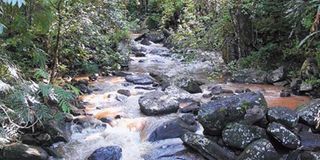Ban on live animal exports bites

What you need to know:
- A butterfly breeding culture whose earnings reached as high as $90,000 per year thrived and consequently, people fell in love with forests and the environment in general to an extent that when villagers opposed the even the harvesting of Lounguza Teak Plantation for fear of losing butterflies which were in plentiful in the plantation.
At the helm of the development of the first nature reserve, in 2003, it was decided to implement a Butterfly production project that would coax villagers into protecting the environment.
A butterfly breeding culture whose earnings reached as high as $90,000 per year thrived and consequently, people fell in love with forests and the environment in general to an extent that when villagers opposed the even the harvesting of Lounguza Teak Plantation for fear of losing butterflies which were in plentiful in the plantation.
However, the dreams and achievements of the 156 butterfly farmers in six villages surrounding the nature reserve suddenly came to a halt last year when the Minister of Natural Resources and Tourism imposed a ban on export of live animals and creatures have now hit extremely hard on villagers from six villagers neighboring the nature reserve.
In a way, according to various editors who visited Fanusi Village, as part of their sojourn during an Editors and Senior Journalists meeting with the Tanzania National Parks (TANAPA), the ban could backtrack on achievements made in engaging villagers surrounding the reserve to take part actively in conservation and protection of the reserve that has received recognition as a Biosphere Reserve.
According to the Conservator of the reserve, Mwanaidi Kijazi, the Amani Nature Reserve was created in 1997 to protect the unique, biologically important sub-montane rainforest ecosystem, and to maintain biodiversity, genetic resources, natural processes and cultural values in an undisturbed, dynamic and evolutionary state for present and future generations.
Ms. Kijazi said that the reserve developed a strategy focusing on developing alternative, non-consumptive uses of the natural resources in the area and income-generating activities, such as eco-tourism, beekeeping, and fish and butterfly farming. “Additionally, the strategy incorporated indigenous knowledge with modern production systems to increase output,” she said.
“We have been able to finance our children’s education. We get at least Sh. 50,000 per month but it depends on your own effort,” a farmer, Mwanaidi Hamis said. More than 50 percent of the farmers are women.
Another farmer, Mohamed Abdullah, said that the government should review the ban and consider each activity on its own merit. “The Government should consider as breeders of butterflies. We are not taking them away from the forests but breeding them and selling the surplus and getting money to make us survive,” he said.
The Butterfly Project Manager, Amiri Said Sheghembe said that after the Minister’s ban the earnings have gone down and worse still the major impact is a loss of farmers and loss of the market.
“The ban has taken a long time, three years and currently there is no hope that the ban would be removed soon,” said Sheghembe, adding that they would be forced to rectify the market situation and coax farmers who have abandoned butterfly farming to go back to the vocation.
He said that the ban has been imposed unilaterally without consultations with stakeholders and it was a general ban that did not consider the kind of creatures that were being exported.
He said that the butterflies are being exported in the larvae form and their lifespan after being hatched is only six days. “”So whether they are exported or not after being bred they would die after six days, anyway,” Sheghembe said.
Jackton Manyerere, Co-owner of the Jamhuri Newspaper, was puzzled as to why the government should impose a ban on an activity that is helping to conserve forests and the environment. “The Government should have consulted farmers and experts before imposing a blanket ban that is affecting people who are helping the government to protect environmental secluded areas,” he said.
“the danger we face here is people abandoning their love for forests and beginning to live on alternative and perhaps destructive activities,” said Gerald Kamwenda of the Tanzania Forest Services Agency(TFS).
According to Ms. Kijazi the butterflies that are being exported are treated as pests by orange farmers in the lowlands and they are being sprayed to death as pests. “we support the ban on certain creatures but the government should rethink the ban on butterflies because not only has affected the farmers, it could have a serious negative impact on efforts to engage villagers in the conservation and protection of the Amani Nature reserve.
The TANAPA Communications Manager, Paschal Shelutete spoke of the need to protect activities that promote conservation such as butterfly farming. TANAPA is also undertaking Community programs as part of its Corporate Social Responsibility (CSR) in its efforts to take on board people living around protected areas to take part in their conservation.
The Amani Butterfly Project was first introduced in 2001 starting with feasibility analysis researching the butterflies of the East Usambara Mountains and their markets with the founder of the Project, Mr. Theron Morgan Brown.
It became operational in 2003 following various awareness and mobilization meetings and trainings in butterfly farming and environmental education activities with technical assistants from the Tanzania Forest Conservation Group (TFCG).
It started with four pilot villages of Shambangeda, Kwezitu, IBC Msasa and Kisiwani and later in 2006, two more villages Shebomeza and Mbomole were included thus making a total of six villages involving 210 farmers. Butterfly farmers in Amani rely on natural forests near their communities as a source of host plants for their butterfly farms.
They also rely on the forest as a source of genetic diversity. Having access to natural forest reduces the capital costs of farming butterflies and allows farmers in the Amani Butterfly Project to compete with wealthier farmers in other parts of the world. This access creates a real link between livelihoods and conservation.
Participating butterfly farmers receive about 70 per cent of the project’s sales and the other 30 per cent covers the project’s staff salaries and operating costs. As sales increase, farmers will receive an even larger percentage.
Although butterfly farming is a side activity for most of the households participating in the project, the average household has seen a 25 per cent increase in income since starting to farm butterflies.
The farmers, more than 50 per cent of whom are women, also control membership in the project. New members are only allowed to join if there is a need for more production.



